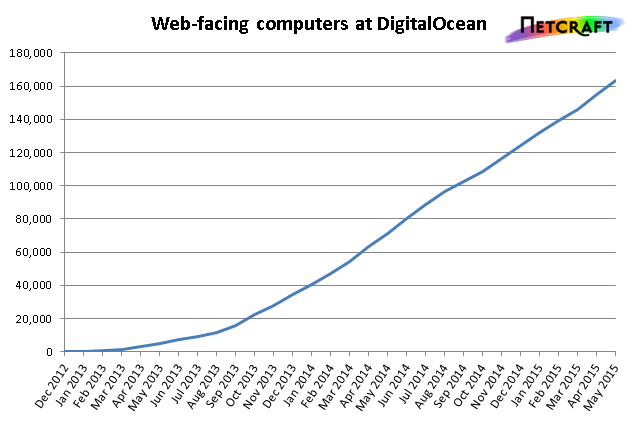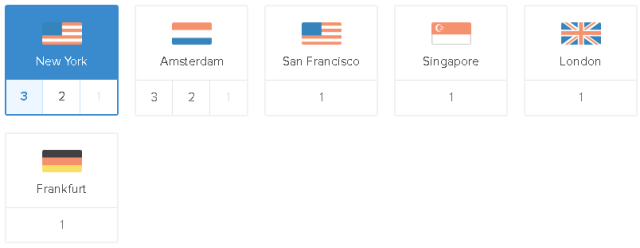DigitalOcean becomes the second largest hosting company in the world
DigitalOcean has grown to become the second-largest hosting company in the world in terms of web-facing computers, and shows no signs of slowing down.
The virtual private server provider has shown phenomenal growth over the past two-and-a-half years. First seen in our December 2012 survey, DigitalOcean today hosts more than 163,000 web-facing computers, according to Netcraft’s May 2015 Hosting Provider Server Count. This gives it a small lead over French company OVH, which has been pushed down into third place.

Amazing growth at DigitalOcean
DigitalOcean’s only remaining challenge will be to usurp Amazon Web Services, which has been the largest hosting company since September 2012. However, it could be quite some time until we see DigitalOcean threatening to gain this ultimate victory : Although DigitalOcean started growing at a faster rate than Amazon towards the end of 2013, Amazon still has more than twice as many web-facing computers than DigitalOcean today.
Nonetheless, DigitalOcean seems committed to growing as fast as it can. Since October 2014, when we reported that DigitalOcean had become the fourth largest hosting company, DigitalOcean has introduced several new features to attract developers to its platform. Its metadata service enables Droplets (virtual private servers) to query information about themselves and bootstrap new servers, and a new DigitalOcean DNS service brought more scalability and reliability to creating and resolving DNS entries, allowing near-instantaneous propagation of domain names.
Other companies are also helping to fuel growth at DigitalOcean. Mesosphere created an automated provisioning tool which lets customers use DigitalOcean’s resources to create self-healing environments that offer fault tolerance and scalability with minimal configuration. Mesosphere’s API makes it possible to manage thousands of Droplets as if they were a single computer, and with DigitalOcean’s low pricing models and SSD-only storage, it’s understandable how this arrangement can appeal to particularly power-hungry developers.
In January, DigitalOcean introduced its first non-Linux operating system, FreeBSD. Although less commonly used these days, FreeBSD has garnered a reputation for reliability and it was not unusual to see web-facing FreeBSD servers with literally years of uptime in the past. In April, DigitalOcean launched the second version of its API, which lets developers programmatically control their Droplets and resources within the DigitalOcean cloud by sending simple HTTP requests.

DigitalOcean added a new Frankfurt region in April 2015.
More recently, DigitalOcean introduced a new European hosting region in Frankfurt, Germany. This is placed on the German Commercial Internet Exchange (DE-CIX), which is the largest internet exchange point worldwide by peak traffic, allowing Droplets hosted in this region to offer good connectivity to neighbouring countries. (An earlier announcement of an underwater Atlantis datacenter sadly turned out to be an April Fool’s joke, despite the obvious benefits of free cooling).
Even so, Amazon still clearly dwarfs DigitalOcean in terms of variety of features and value-added services. Notably, Amazon offers a larger variety of operating systems on its EC2 cloud instances (including Microsoft Windows), and its global infrastructure is spread much wider. For example, EC2 instances can be hosted in America, Ireland, Germany, Singapore, Japan, Australia, Brazil, China or even within an isolated GloudGov US region, which allows US government agencies to move sensitive workloads into the cloud whilst fulfilling specific regulatory and compliance requirements. As well as these EC2 regions, Amazon also offers additional AWS Edge Locations to be used by its CloudFront content delivery network and its Route 53 DNS service.
Yet, as well as its low pricing, part of the appeal of using DigitalOcean could lie within its relative simplicity compared with Amazon’s bewilderingly vast array of AWS services (AppStream, CloudFormation, ElastiCache, Glacier, Kinesis, Cognito, Simple Workflow Service, SimpleDB, SQS and Data Pipeline to name but a few). Signing up and provisioning a new Droplet on DigitalOcean is remarkably quick and easy, and likely fulfils the needs of many users. DigitalOcean’s consistent and strong growth serves as testament to this, and will make the next year very interesting for the two at the top.
Voir en ligne : http://news.netcraft.com/archives/2...
 L’Imp’Rock Scénette (by @_daffyduke_)
Logiciel libre, rock’n roll et biochimie ...
L’Imp’Rock Scénette (by @_daffyduke_)
Logiciel libre, rock’n roll et biochimie ...